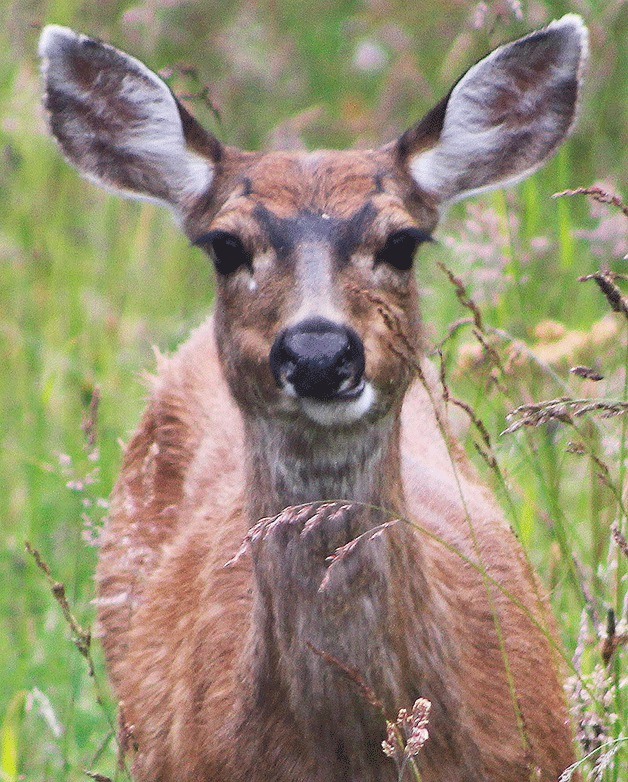While walking home from the Coupeville Post Office earlier this month, Theresa Carr was attacked by a deer.
The “teenage” doe started following closely behind her and her dog near the library and she shooed the animal away, Carr said.
She thought the deer was gone, but it suddenly pounced at her from a hedge, leaping over her and nearly clipping her head with its hooves.
“It was like a mountain lion jumping out of the bushes,” she recalled
The rampaging deer then turned toward her in a menacing manner. That prompted a passing motorist by to stop and offer Carr, and her dog, a safe place inside her car.
They got a ride home in safety.
WHILE CARR’S frightening encounter with a deer may be atypical, interactions between the human and deer populations on Whidbey Island are becoming more common. Deer can commonly be seen along the side of roads and in fields. They even make their way into neighborhoods in Coupeville and Oak Harbor where gardens and flower beds offer easy grazing.
To gauge public opinion of the ubiquitous Columbian blacktail deer on Whidbey Island, a graduate student from the University of Montana is working with the state Department of Fish and Wildlife to survey a sampling of residents.
Rob Wingard, an Anacortes resident, said he mailed 2,000 questionnaires this week to randomly selected addresses. He’s already quite a few back already and found people have pretty strong feelings about the dainty ungulates.
“People are really passionate about them,” he said. “Some people love them, others can’t stand them because they get into their gardens and in front of their cars.”
WINGARD SAID he plans to go out into the field to form an estimate of the number, and distribution, of deer on Whidbey.
Ruth Milner, a biologist with Fish and Wildlife, said her department can use the information from the study to improve the management of deer on the island. Any effort to increase deer hunting on the island, for example, won’t work well if the public is against the notion.
The main concern with the deer population is the pervasiveness of car crashes involving the animals, she said.
About 150 car-versus-deer accidents occur each year, which is a big number given the size of the island, Milner said.
Whidbey Island technically isn’t overpopulated with deer because the deer population hasn’t resulted in any adverse health effects, she said.
The white and spotted deer that frequent the Coupeville area don’t suffer from a health disorder. The “piebald characteristic” comes from a recessive gene, Milner said.
Island-wide, the number of deer is “clearly very high,” she said, and it’s all people’s fault.
Bears, wolves and even cougars used to live on Whidbey Island and kept the deer population in check, Wingard said. However, settlers killed all of the natural predators soon after arriving on Whidbey in the mid-1800s.
Since that time, there’s been a dash to clear woods, creating perfect habitat for the deer.
“It’s the perfect storm of habitat and security,” he said. “They are animals that have no natural enemies other than cars and hunters.”
Blacktail deer populations are hard to count, Milner said, because they don’t form herds like other deer do, but hang out in small family groups.
Wingard said he will create an estimate by walking randomly selected survey lines and counting deer head early in the morning, then using a computer model to come up with a number and distribution.
Wingard said the Columbian blacktail deer populate a range that runs west of the Cascade Mountain, from the middle of British Columbia to Central California. They are a subspecies of mule deer, but are smaller than either mule or whitetail deer.
In fact, Wingard said, blacktail deer living on the island may be smaller than their mainland cousins.
A Fish and Wildlife study from the 1960s concluded that “hog dressed” deer shot on Whidbey averaged about 70 to 75 pounds, significantly less than blacktail hunted on the mainland.
The only effective way to control deer population is by hunting; deer birth-control efforts have been made in the Eastern United States, Milner said, but they were extremely expensive and simply didn’t work well.
“We don’t have a lot of tools in our toolbox,” she said.
Milner said Wingard’s study will help her gain a better understanding of what residents think about deer. That’s key to pursuing any kind of tenacious plan to encourage more hunting on Whidbey, she said.
If increased hunting seems likely to cause an outcry, then the state probably won’t go in that direction.
Finding a safe place to hunt deer on the island may be difficult because of the proximity to homes to the wilder areas where deer congregate. Since the state doesn’t allow hunting in state parks on the island, the only public lands where hunters can go are small parcels owned by Island County, Milner said.
As a result, state Fish and Wildlife has a program to work with private landowners who are willing to open up their property to hunters during hunting season. Fish and Wildlife program allows the landowners to set the parameters for hunting on their property.
“It’s tailor made to the landowners’ needs and desires,” she said.
CURRENTLY, HOWEVER, only one Whidbey Island landowner is enrolled in the program.
Wingard said he hopes to complete his thesis over the next year and urges residents who receive his questionnaire to return them as soon as possible.
As for Carr, the interaction with the aggressive deer provided her with a “crazy story” to share with friends, but it hasn’t soured her opinion of deer.
Carr said said she’s learned to respect them more as wild animals, though she’s more watchful of her surroundings when she’s outside.
As someone who’s also hit a deer and wrecked her car, Carr admits she is concerned about the large population of deer on Whidbey Island.
Whether hunting is the answer, though, she said she doesn’t know.



